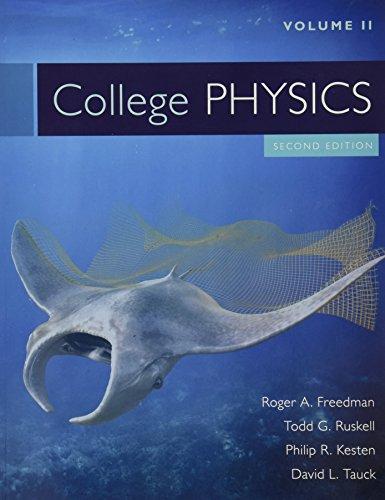
Concept explainers
(a)
The three smallest angles on the either side of central maximum at which no light will reach the cat's retina and it is assumed the eyeball of cat is filled with air.
Answer to Problem 104QAP
1st smallest angle =
2nd smallest angle =
3rd smallest angle =
Explanation of Solution
Given:
Width of slit =
Formula used:
Following equation satisfy for the diffraction of single slit,
Calculation:
Since, w is very small to
In this situation, we can apply the following approximation,
Now, let's plug all values in above equation,
Conclusion:
So, the three smallest angles on the either side of central maximum at which no light will reach the cat's retina and medium inside the eye ball is air are
(b)
The three smallest angles on the either side of central maximum at which no light will reach the cat's retina and it is assumed the eyeball of cat is filled with a liquid having refractive index 1.4.
Answer to Problem 104QAP
1st smallest angle =
2nd smallest angle =
3rd smallest angle =
Explanation of Solution
Given:
Refractive index fluid that is in the eyeball,
Wavelength of light in air =
Width of slit =
Formula used:
Wavelength of light in medium is written as,
Calculation:
Wavelength of light in fluid,
Now, from above formula,
Let's plug all values,
Conclusion:
Thus, the three smallest angles on either side of retina of cat's eye when eyeball is filled with fluid having refractive index
(c)
The explanation of the order of fringes due to diffraction of light by cat's eye
Answer to Problem 104QAP
Cat cannot distinguish the location of fringe on the retina.
Explanation of Solution
From above discussion, we can see that angle of diffraction of light on either side of central bright spot of the retina is very small. So, location of bright and dark fringes would be very close to each other. Cat's eye has no ability to perceive that order of fringes. So, cat would perceive it as continuous bright light not as alternate dark and bright that occurs due to diffraction.
Conclusion:
Thus, cat would not see that alternate dark and bright fringes.
Want to see more full solutions like this?
Chapter 23 Solutions
College Physics Volume 2
- If b is Brewster's angle for light reflected from the top of an interface between two substances, and b is Brewster's angle for light reflected from below, prove that b+b=90.0.arrow_forwardCalculate the wavelength of light that has its third minimum at an angle of 30.0° when falling on double slits separated by 3.00 m. Explicitly, show how you follow the steps in Problem-Solving Strategies for Wave Optics.arrow_forwardCalculate the wavelength of light that has its thirdminimum at an angle of 30.0º when falling on double slitsseparated by 3.00 μm . Explicitly, show how you follow thesteps in Problem-Solving Strategies for Wave Optics.arrow_forward
- Does refraction make a swimming pool seem deeper or shallower? Explainarrow_forwardCalculate the wavelength of light that has its third minimum at an angle of 30.0° when falling on double slits separated by 3.00 m. Explicitly show how you follow the steps from the Problem-Solving Strategy: Wave Optics, located at the end of the chapter.arrow_forwardWhat are the three smallest non-zero thicknesses of soapy water (n=1.33) on Plexiglas if it appears green (constructively reflecting 520-nm light) when illuminated perpendicularly by white light? Explicitly show how you follow the steps in Problem Solving Strategies for Wave Optics.arrow_forward
- Find the minimum thickness of a soap bubble that appears red when illuminated by white light perpendicular to its surface. Take the wavelength to be 680 nm, and assume the same index of refraction as water.arrow_forwardCat’s eyes have pupils that can be modeled as vertical slits. At night, would cats be more successful in resolving (a) headlights on a distant car or (b) vertically separated lights on the mast of a distant boat?arrow_forwardw9-12 The uncorrected far point of Colin’s eye is 4.40 m. What refractive power contact lens enables him to clearly distinguish objects at large distances? _____Darrow_forward
- is this statement True or False? in the eye the greatesy refraction of lighy from >6m occurs qt the air cornea interface.arrow_forwardCalculate the angle of refraction at the air/core interface. • nair = 1, ncore = 1.47, ncladding = 1.45, incident = 30oarrow_forwardA friend lends you the eyepiece of his microscope to use on your own microscope. He claims that since his eyepiece has the same diameter as yours but twice the focal length, the resolving power of your microscope will be doubled. Is his claim valid? Explain.arrow_forward
 College PhysicsPhysicsISBN:9781938168000Author:Paul Peter Urone, Roger HinrichsPublisher:OpenStax College
College PhysicsPhysicsISBN:9781938168000Author:Paul Peter Urone, Roger HinrichsPublisher:OpenStax College Physics for Scientists and EngineersPhysicsISBN:9781337553278Author:Raymond A. Serway, John W. JewettPublisher:Cengage Learning
Physics for Scientists and EngineersPhysicsISBN:9781337553278Author:Raymond A. Serway, John W. JewettPublisher:Cengage Learning Physics for Scientists and Engineers with Modern ...PhysicsISBN:9781337553292Author:Raymond A. Serway, John W. JewettPublisher:Cengage Learning
Physics for Scientists and Engineers with Modern ...PhysicsISBN:9781337553292Author:Raymond A. Serway, John W. JewettPublisher:Cengage Learning Glencoe Physics: Principles and Problems, Student...PhysicsISBN:9780078807213Author:Paul W. ZitzewitzPublisher:Glencoe/McGraw-Hill
Glencoe Physics: Principles and Problems, Student...PhysicsISBN:9780078807213Author:Paul W. ZitzewitzPublisher:Glencoe/McGraw-Hill University Physics Volume 3PhysicsISBN:9781938168185Author:William Moebs, Jeff SannyPublisher:OpenStax
University Physics Volume 3PhysicsISBN:9781938168185Author:William Moebs, Jeff SannyPublisher:OpenStax Principles of Physics: A Calculus-Based TextPhysicsISBN:9781133104261Author:Raymond A. Serway, John W. JewettPublisher:Cengage Learning
Principles of Physics: A Calculus-Based TextPhysicsISBN:9781133104261Author:Raymond A. Serway, John W. JewettPublisher:Cengage Learning





